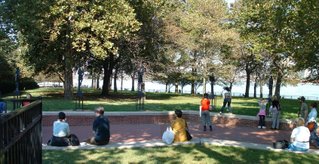Nature As An Architect
Sunday, November 26, 2006 Labels: Evolution Of Human Race, My Travels 1 comments
During a whirlwind tour of Bhopal (the capital of State of Madhya Pradesh), I came to know of ancient cave art site called “Bhimbetka” – some 45 KMs away. Being interested in evolution of Man, I immediately decided to visit it. I had not known that such sites were there in India (despite its ancient civilization), although I had heard that these were discovered in Europe and USA.
Bhimbetka means the place where Bhim (A revered mythological figure) used to sit.
It was mind-boggling.
BTW – ancient cave art is called “Petroglyphs”. The word comes from the Greek words petros meaning "stone" and glyphein meaning "to carve". These are left by Neolithic men from about 10,000 yrs BC onwards.
What I learned about the petroglyphs, you can find a description also at Wikipedia.
But the point that has been missed in all its descriptions are the Geographic - Architectural beauty of the rocks in which these caves are. These rocks are said to have been under water in a river or a lake much before Neolithic men came on earth. This site was part of “Gondwana” continent which moved away from Africa and later abutted Asian plate and became Indian peninsula. The action of water has sculpted the rocks. These look like a multistoried skyscraper, with caves at various levels. There is a marked appearance of windows (holes) carved in rock. Many caves have natural ventilating openings in the rear. Stones lie atop other rocks, perfectly balanced on a point. You see Nature as an Architect. You feel the emrging balance between malleable flow of stone imparted by the power of hydraulics - in opposition to hardiness of rocks. The whole area has a playful architecture - A narrow opening leads you to a sudden vast open area. In fact this fairy-tale site is fit to excite the artist in you. No wonder that world’s best petroglyphs were created here.
These rocks are said to have been under water in a river or a lake much before Neolithic men came on earth. This site was part of “Gondwana” continent which moved away from Africa and later abutted Asian plate and became Indian peninsula. The action of water has sculpted the rocks. These look like a multistoried skyscraper, with caves at various levels. There is a marked appearance of windows (holes) carved in rock. Many caves have natural ventilating openings in the rear. Stones lie atop other rocks, perfectly balanced on a point. You see Nature as an Architect. You feel the emrging balance between malleable flow of stone imparted by the power of hydraulics - in opposition to hardiness of rocks. The whole area has a playful architecture - A narrow opening leads you to a sudden vast open area. In fact this fairy-tale site is fit to excite the artist in you. No wonder that world’s best petroglyphs were created here.
I have decided to return to it with my painting material later – although I haven’t painted for last 10-12 years. I will post the pictures of the rocks later.
The petroglyphs at Bhimbetka are a continuous series of paintings by generations of Humans dating from 10,000 BC to about 400 AD. The initial ones are in white chalk and the latest ones in red mineral - still used in India for religious ceremonies – it’s called “Geru”. Intermediate ones are in vegetable dyes of yellow and green colour. My surmise is that some others may have been lost since they might have experimented with dyes which are not so permanent.
Themes also show differences. Those in white from 10,000 BC only show hunting of animals by co-operating gangs of men. While the ones in red – the latest ones – also show two men fighting each other with spears (photo above). Progress of civilization!










